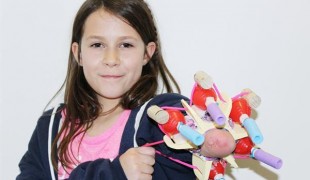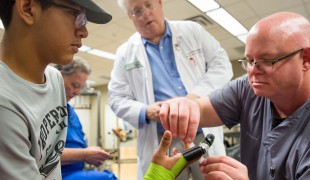- 5748
- 466
- 9
- 10
- 0
- Help Ukraine
About the solution
Ben Ryan, who invented the ‘revolutionary’ arm after being told by doctors there was nothing they could do, is trying to raise £150.000 to develop the ingenious device. He looked for another way and eventually used the Microsoft Xbox Kinect scanner plugged in to his laptop to easily scan Sol’s arm while he was asleep. He taught himself the basics of product design and development, using Fusion 360 software.
Ben Ryan dreamed of building the prototype after being told by The National Health Service doctors there was nothing they could do for lovable baby Sol until he was at least a year old.
After complications led to Sol’s left arm being amputated below the elbow at just 10 days of age, Ben was not prepared to wait, and after coming up with designs, he manufactured the limb on a 3D printer.
Surgeons advised amputation through the elbow joint but Ben and his wife Kate persuaded them to save as much of their son’s lower arm function as possible. After being told about the lack of help available, he began his own project and within two months the inventor had managed to design and print the first working system, though it was too small for Sol to wear.
He knew he needed to scan Sol’s arm, but was concerned he may not keep still long enough to produce a scan using the sensitive Artec scanner at Bangor University.
Ben is now working closely with Paul Sohi from software company Autodesk and Sol, now two, can use his arm to grip and power the hydraulic arm.
“I’ve been on an extraordinary journey over the past two years which started when my son was born. Sadly, Sol lost most of his lower left arm due to a blood clot following an injury at birth”, Ben said.
The former psychology lecturer has now set up a crowdfunding page to raise £150.000 so other children who have lost limbs can benefit, as the project is in a ‘desperate situation’ and could flounder without financial help.
“Its different technology to what is out there already. I just really need to finish the development of the prototype and once that is done I can start getting his arm to hundreds and thousands of other children around the world”, Ben explained.
Adapted from:
http://bit.ly/2Apv8nh
http://bit.ly/2y7LjoA
More info:
http://bit.ly/2iIgOvv
http://www.mirror.co.uk/all-about/nhs
http://bit.ly/2BenVU3
This solution shall not include mention to the use of drugs, chemicals or biologicals (including food); invasive devices; offensive, commercial or inherently dangerous content. This solution was not medically validated. Proceed with caution! If you have any doubts, please consult with a health professional.
DISCLAIMER: This story was written by someone who is not the author of the solution, therefore please be advised that, although it was written with the utmost respect for the innovation and the innovator, there can be some incorrect statements. If you find any errors please contact the patient Innovation team via info@patient-innovation.com
-
-
646
-
0
-
9597

Girl invents way to get new attachments for her 3D printed arm
Grip
Limb Deformity
Hand Deformity
Elbow Deformity
Prosthesis
3d Printed
Body-Worn solutions (Clothing, accessories, shoes, sensors...)
Assistive Daily Life Device (to help ADL)
Muscle weakness
Limited range of motion
Reduced grip force (grip)
Loss of muscle coordination
Restoring mobility
Replacing lost limbs
Maintaining Balance and Mobility
General and Family Medicine
Medical Genetics
Pediatrics
United States
-
-
-
425
-
1
-
10286

Man 3D prints finger for boy to help him play baseball better
-
-
-
473
-
0
-
6563

Father develops 3D printing prosthetic arm for his son
-
 en
en